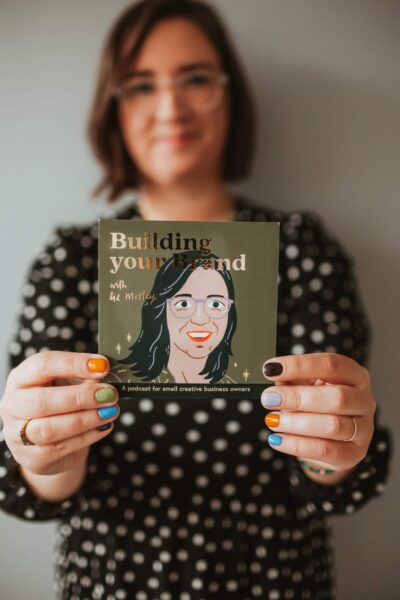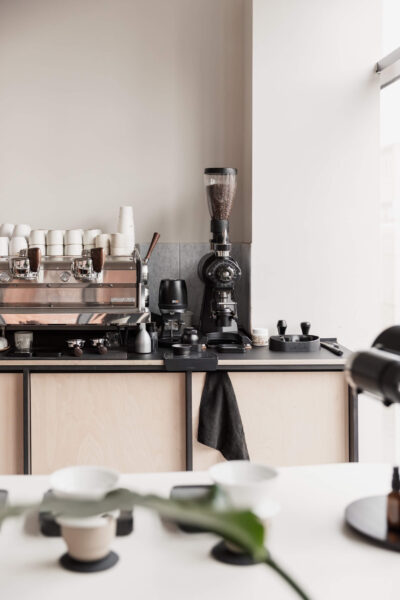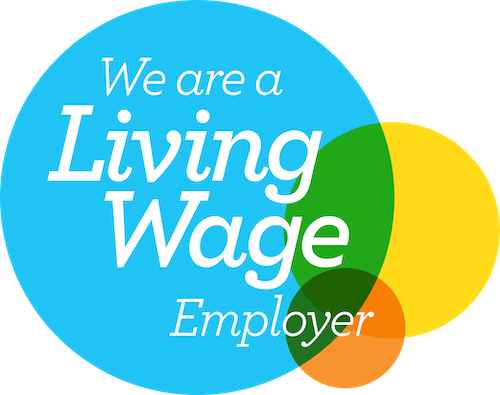Studio Cotton founder Aime recently discovered in Google Search Console that “homepage SEO for online shops” is something that y’all are searching for and finding us.
So today, my job is to write this helpful blog post for anyone with an online shop who wants to improve their homepage for SEO (search engine optimisation) purposes.
Here’s a lil caveat – much of what we do for homepage SEO on ecommerce websites (otherwise known as online shops) is very different to what we do for service businesses. Some things that are really good for homepage SEO – such as having meaty, wordy content – are not very good for the UX (user experience) of an online shop.
The content on an e-commerce website needs to be snappy, because we want to get a visitor from the home page, to a product, to the checkout ASAP, so having a super wordy homepage probably won’t help maximise conversions and sales.
Whereas on a service business website, we kind of want to slow users down so that we can get loads of lovely useful information into their brain – it’s a slower sell, and potential customers generally want to gather more information before investing.
So that’s why we wanted to separate this helpful info into its very own article, to help you to focus on the things that are good for ecommerce homepage SEO, but won’t get in the way of you having a website that increases the chances of someone making a purchase.
Let’s go.
1. Create 5-10 distinct sections on your homepage for SEO opportunities
Sure, we want the content on an ecommerce website to be snappy, but we still want some content – it makes us sad when we see a homepage with barely any content or copy on it. Google needs to “read” the words on your website to understand the context, as do your human customers.
One of the things you can do to improve your homepage SEO is to give yourself more space to talk about your business and products, and to include keywords and topics that are relevant to your business.
If you’re not sure what your keywords are, use Aime’s legendary Everyday Keyword Exercise, which you can find in this Instagram post.
The ‘O’ of SEO is about optimising every inch of your website to attract more search engines, so if you have a really small homepage (that could look something like one banner and one product feed), you literally don’t have many inches to optimise.
Whenever we design an ecommerce client’s homepage, we include 5-10 different distinct sections that allow us to blend compelling, seasonal content with oodles of SEO keywords.
These sections can be areas where you can communicate something – ideally an exciting mixture of banners, product feeds, story sections, etc.
Below you can see a small section of the Lauren Aston Designs website (built by us – click through to see the homepage in all its glory) which shows the distinct difference between banners and product feeds, and how you can lay them out to create a homepage that is both search engine optimised and visually pleasing.
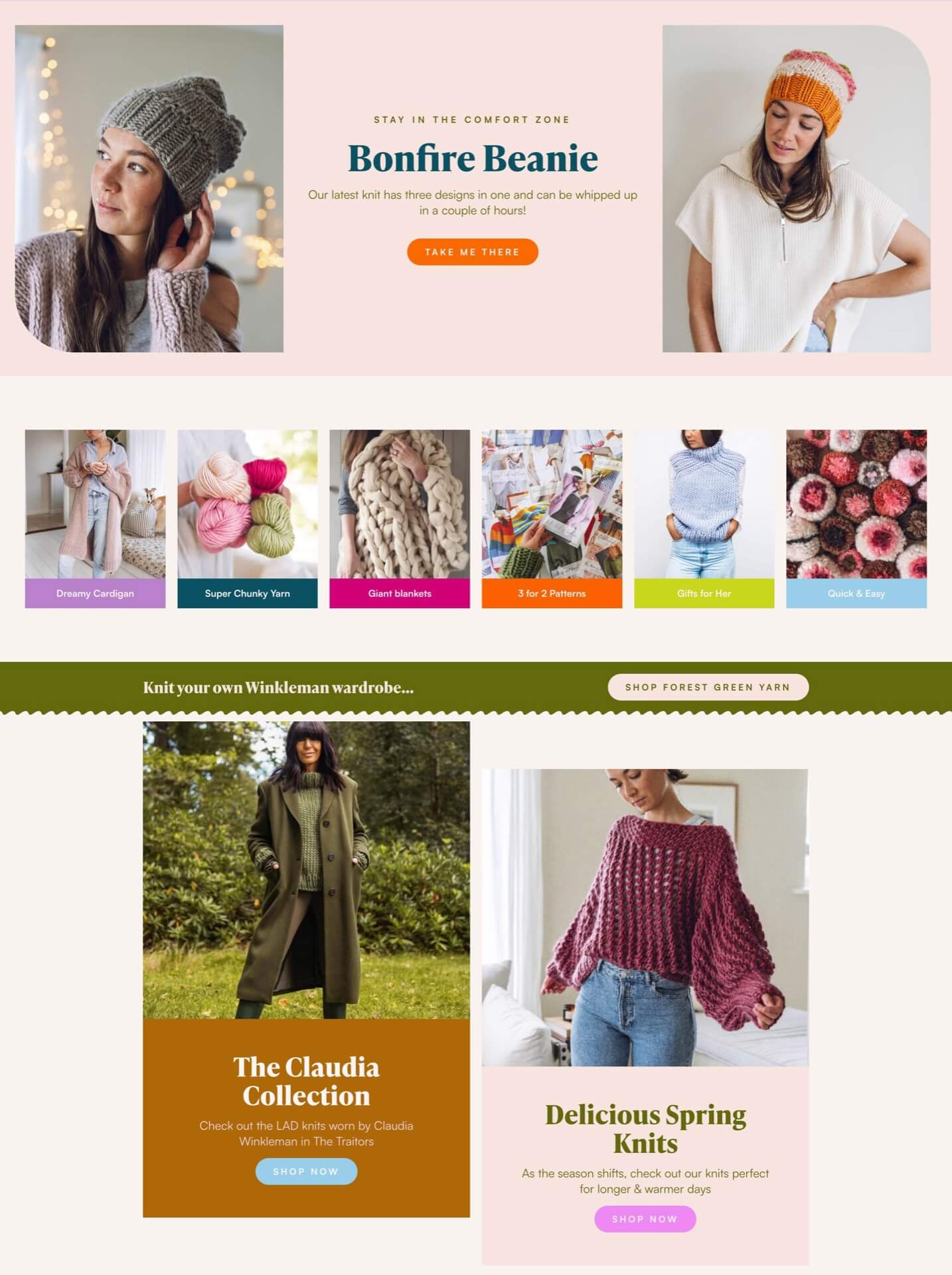
And on the Good Fabric website, another ecommerce website that we built and love to show off, because look at it. The homepage has tonnes of different sections, with room for plenty of keywords, and a fair few puns too.
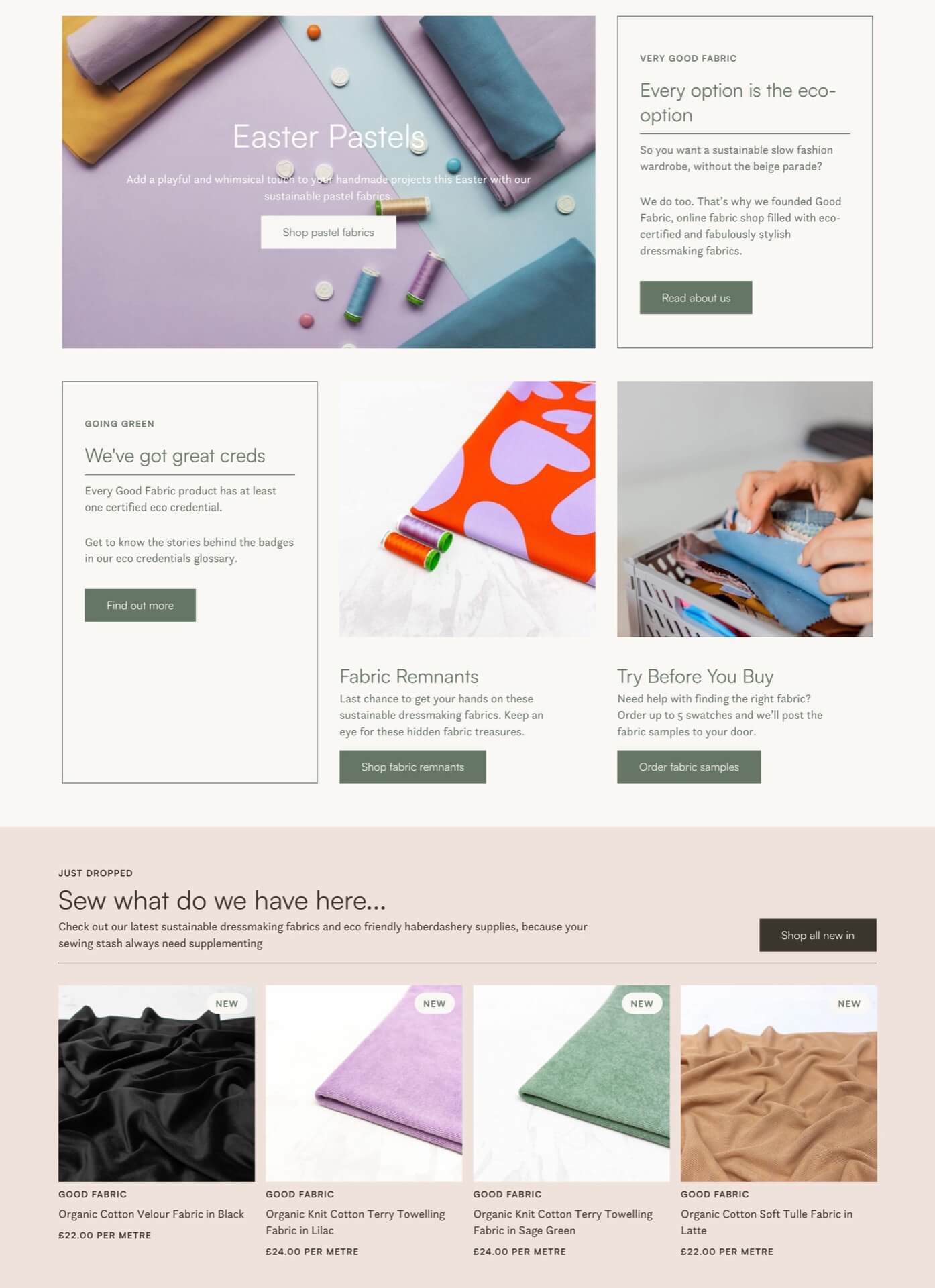
2. Remember your homepage section formatting
By formatting, we mean aiming to include a heading, subheading, body, and button in each section of your homepage – this is another tip for increasing the quantity of content on the page without having any essays or long paragraphs.
The format of heading, subheading, body and button gives you four layers of information that you can include in any one of the individual sections mentioned in our last point. That’s four different locations per section to include SEO keywords (as opposed to just a button or just a heading).
Going back to Good Fabric for a sec, you can see that in this section there’s the small subheading first, then heading (see our next point for heading hierarchy 😉 ), body text, and a button – and just look at all those keywords in there.
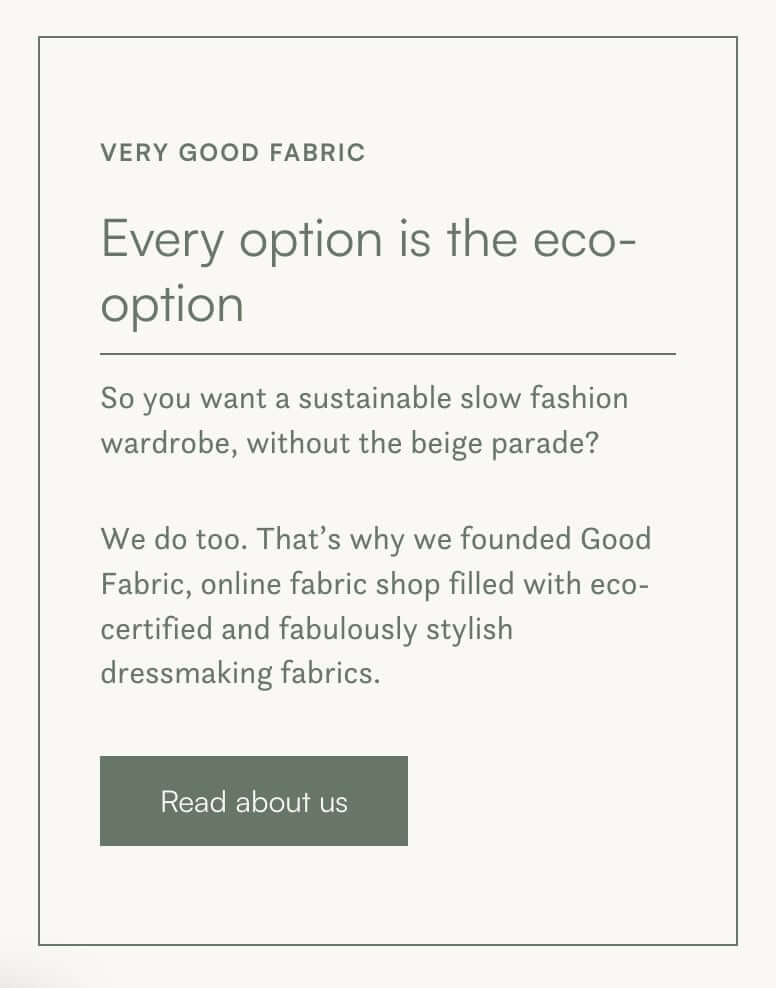
Some website platforms (like Shopify in particular) tend to only have the option for banners with just a button on them, but with the website building technology we use (WordPress with Elementor) we can add much more depth and many more opportunities for keywords.
3. Use your homepage headings correctly
While formatting your homepage, you need to make sure you use the correct headings.
Headings are used to indicate different levels of importance and have a specific practical meaning. They create a hierarchy of content, highlighting the most important parts of a page, product or blog post, so that Google understands what your website is all about.
You only need one H1 per page – this will usually be the title of your page or blog post, or the big banner at the top, and is the most important to Google.
Next, you’ll need a heading for each section you created for point 1 – these should be H2s. It’s likely that you won’t need to break sections down into further headings, but if you do, they should be H3s.
I’m sure you can guess that you don’t want to be using these headings willy-nilly as it can totally ruin your homepage SEO. The very last thing you want to do is tell Google “hey, this content is the MOST important thing on my homepage” by marking it up as an H2, when really it’s just some random testimonial or heaven forbid, a random add-to-cart button.
If you’re not sure whether you’ve already nailed this, we recommend using Wave to review your heading hierarchy – you just pop your url into the box, and on the next page select the “structure” option on the left.
This will help you determine whether you’re giving Google a nice, clear picture of what your business is about – particularly in that moment, because as we’ve said before, ecommerce websites need to be seasonal.
4. Ban yourself from bland H2 headings
The most problematic H2s are keywordless, like “new in” or “best sellers” or “follow us,” as none of these headings give Google any evidence as to what your small business is about.
Even just tweaking homepage headings slightly to say “latest ceramics for pumpkin spice lattes” or “best selling cosy Christmas styles” or “follow [business name] on Instagram” gives Google so much more context.
Think about how you can upgrade those dull H2s (like the ones below) to make them a bit more specific to your business or products, and reap the homepage SEO rewards.
5. Have an about intro section on your homepage
If you’re still panicking about the 5-10 sections I mentioned in my first point, let me help you out with getting one ticked off right now.
Make one of your homepage sections a micro business bio, with brand keywords like your business name, location, and top-level product keywords. Add a button to your about page, for those customers who wanna know a lil more.
People in general love supporting small businesses, so your website’s homepage is a really good place to make it clear that you are a small business, as well as it being a great place to share a brief overview of your values.
Most of the year, that about section can live about a third of the way down your homepage. During the run up to Christmas, I tell everyone to shove that mini bio right down to the bottom of their homepage, as you want the prime spots for selling.
6. Create seasonal content for your homepage
…and publish it a few weeks before you want it to pay off.
Google flippin’ loves seasonal content, because customers love seasonal content. Of course we do – the hats we buy in winter are very different to the hats we buy in the summer, so we wanna make sure that your homepage is continually updated with the seasons.
You need to visually merchandise your online shop like you would a physical, bricks-and-mortar shop; you need to present your products to maximise sales.
The sections on an ecommerce homepage are similar to those of a shop – the top of your homepage is like the shop windows, the first thing potential customers will see. The next section is like the front shelves of the shop, and so on.
Try to always create seasonal content for the obvious ones like Christmas, Valentine’s Day, Mother’s Day, etc. But it’s also worth going seasonally-specific, like we mentioned in point 4 – “latest ceramics for pumpkin spice lattes.”
Being seasonal really helps you to rank with what people are searching for right now, so be specific, be silly. Mention April showers or back to school if it’s relevant to your products.
7. Update your homepage every 1-4 weeks
Another thing that Google loves to see is a website that is updated regularly. A great way to think about this is how you would change up the displays in a physical shop at different times of the year, and then apply that to sections of your homepage.
Instead of visual merchandising your physical shop, you’re digital merchandising your online shop.
It doesn’t have to be 10 new banners every week or month. In fact, we definitely don’t want it to be 10 new banners or sections every single month or every single week, we just wanna make small changes.
For example, if you’re a ceramicist, it might look like your pumpkin spice latte cups being towards the bottom of the page in September, but in the first week of October, it’s the very top banner at the top of your homepage.
8. Don’t put all of your SEO eggs in this one basket
Whilst your homepage is super important when it comes to your ecommerce website’s SEO, it’s not the only area to work on… to make the biggest difference on your website, I’m gonna go ahead and guess that your product descriptions could actually use your TLC first.
Spending hours on your homepage every month is unlikely to have as big an impact as writing all of your product descriptions, tweaking them, making sure they’re keyword-heavy, and creating seasonal collections.
We’ve got a faaaantastic blog article on writing thorough product descriptions – 9 enticing details of a really, really good product description – and if you’re still struggling to find the time or words, we can write them for you.
Here’s a shameless plug for our SEO product descriptions service, because we blimmin’ love writing words for small businesses.
I’m going to end here with another one of Aime’s brilliant Instagram posts that you should defo flick through before embarking on your homepage SEO makeover…



